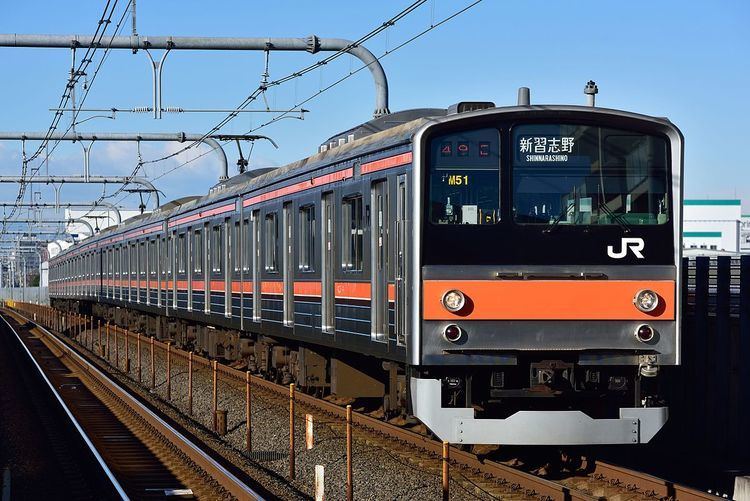In service 1985-present Constructed 1984-1991 | Replaced 103 series Number built 1,461 vehicles | |
 | ||
Manufacturer Hitachi, Kawasaki Heavy Industries, Kinki Sharyo, Nippon Sharyo, Tokyu Car Corporation, JR East Ōfuna Works Formation 2, 3, 4, 6, 8 or 10 cars per trainset | ||
The 205 series (205系, Nihyaku-go-kei) is a commuter electric multiple unit (EMU) train type introduced in 1985 by Japanese National Railways (JNR), and currently operated by East Japan Railway Company (JR East) and West Japan Railway Company (JR-West).
Contents
Operations
(in alphabetical order)
Former operations
Design variants
There have been many variations of the design of the 205 series trains.
Below is a list of photos for various 205 series designs as indicated by the liveries of the lines they serve.
205-600 series
The 205-600 subseries was created in 2013, when cars from former Keiyo Line 10-car sets were reformed between 2012 and 2013 to create twelve four-car sets for use on Nikko Line and Utsunomiya Line services, entering service from 16 March 2013, replacing ageing 107 series and 211 series sets. The four Nikko Line sets are finished in a livery with "classic ruby brown", "gold", and "cream" bodyside stripes. The Utsunomiya Line sets are finished in a livery with Shonan green and orange bodyside stripes.
Formations
The four-car sets, numbered Y1 to Y12, are formed as shown below, with two motored (M) cars and two non-powered trailer (T) cars.
Interior
Passenger accommodation consists of longitudinal bench seating throughout. A universal access toilet was added to the KuHa 205-600 car at the time of conversion.
Fleet list
Source:
Senseki Line "Mangattan Liner" trains
A Senseki Line 205-3100 series "Mangattan Liner" trainset is decorated with images of the cartoon character Robocon from the 1970s anime Ganbare!! Robocon, while another ("Mangattan Liner II") has Kamen Rider livery. Both were created by Shotaro Ishinomori, a native of Ishinomaki, Miyagi; Ishinomaki Station is the terminus of the Senseki Line.
Fuji Kyuko
A number of former 205 series trains were sold to Fuji Kyuko in 2011 and modified to become 3-car 6000 series sets, entering service from February 2012. Four more withdrawn JR East 205 series cars (KuHa 205-107 + MoHa 205-287 + MoHa 204-287 + KuHa 204-107) were resold to Fuji Kyuko following withdrawal in November 2016.
Indonesia
A total of 476 units (60 sets) from withdrawn Saikyo Line, Yokohama Line, and Nambu Line sets were shipped to Jakarta from late 2013 to early 2016.
Former Saikyo Line sets
A total of 18 withdrawn Saikyo Line ten-car sets (180 vehicles) were shipped to KA Commuter Jabodetabek (KCJ) in Jakarta, Indonesia, in 2013, and entered service from March 2014. The sets in use are former Kawagoe sets 1, 4, 7, 11 to 15, 18, 20, 22 to 26, and 30 to 32. All except sets 26, 30, and 32 include pairs of SaHa 204 cars with six pairs of doors per side. Sets 30 to 32 were originally Yamanote Line sets, distinguished by their smaller door windows. Set 23 was the first set to have a pair of LCD screens inside all cars, except SaHa 204 cars. Set 23 was also the first set to have working LED destination display in KuHa 204 and KuHa 205 cars. Set 15 and 32 were involved in a train accident in Juanda Station, Jakarta.
Former Yokohama Line sets
From July 2014, 22 withdrawn Yokohama Line eight-car sets (176 vehicles) were shipped to Jakarta.
Former Nambu Line sets
In 2015, 20 withdrawn Nambu Line six-car sets (120 vehicles) were shipped to Jakarta. The former Nambu Line sets are used on 12-car operations.
